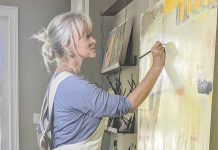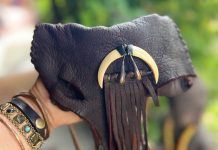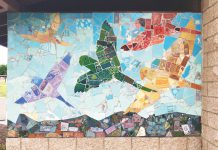Since arriving in Southern California in 1989, painter Hugo Rivera has drawn inspiration from the same surroundings he continues to impact.
At just 6 years old, Laguna Beach-based artist Hugo Rivera could be found coloring with crayons, a gift, along with other art materials, from his father. Back then, Hugo’s “studio” was the floor of his father’s home office in Guadalajara, Mexico. “He never kicked me out of the office, giving me paper and allowing me to sketch on the floor,” Hugo recalls of his father, the late Jose Rivera. “I’m pretty sure [he] saw something in me.”
Jose’s intuition was proven accurate in February 2013 when Hugo, now 48, celebrated the first anniversary of the opening of the Hugo Rivera Gallery, perhaps his crowning achievement in a town known the world over as an artists’ colony. Jose, a former topographer, sparked his son’s creative talents and affected his education—an influence that doesn’t go unrecognized by the painter today.
From a humble beginning with crayons and black-and-white sketches grew an artist whose work experiments with bold colors, textures, rhythm and a flow that provokes an emotional response from anyone who views his vibrant acrylic paintings of the female form. The abstracted bodies and faces are on display in Hugo’s intimate gallery, a place where four other artists, including fellow acrylic painter Joni Cresci, share space.

“He’s a leader in the arts … community, which needs to grow,” says Joni, who has also been a student of Hugo’s, having taken three of the gallery’s on-site workshops led by the artist. “He’s for the community and makes Laguna a better place in the art world. He’s making his mark on the town.”
One of Hugo’s main priorities in Laguna involves recognizing and mentoring talent like Joni, a Laguna transplant with an art pedigree that includes time spent as a printmaker in Northern California and a degree from San Francisco State University. She moved to Southern California two years ago and took her first workshop with Hugo in September 2011. She admits that she disliked painting on canvas until Hugo unleashed that aspect of her artistic talent, effectively giving her an entirely new creative foundation.
“I’ve been able to grow,” she muses. “He helped me open up. Sometimes you just meet those people in life that create changes.”
Creative Evolution
Though decidedly deconstructed, Hugo’s work reflects a background rooted in science. Despite seeming destined to become an artist since childhood, he made the decision 30 years ago to get a degree in civil engineering, graduating from the University of Guadalajara in 1987. At the time he didn’t see art as a potential career, he says, and chose to pursue engineering because of its practicability. In the end, however, his creative side won out over its logical counterpart, and with his father’s support as motivation, he made the move to become a full-time artist.
He relocated to the United States in October 1989, composing mainly black-and-white sketches using graphite and charcoal pencils, and even Sharpie pens and markers, which he discovered upon arriving in the U.S. “It’s amazing,” he says of the brand. “My sketches were done with Sharpies; they didn’t smear. When I sketch a model, I use Sharpies. … I love the dark and richness of black and white.”
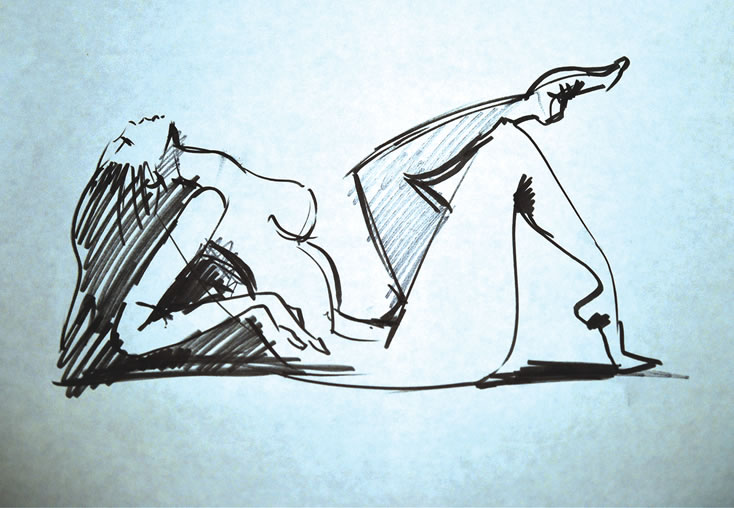
His engineering background became an asset as early as the 1990s, when he began fielding commissions to paint murals in both churches and residences. A 30-foot mural in the St. Francis of Assisi Church in Huntington Park, Calif., was commissioned in 2001, of which Hugo remarks, “My civil engineering helped me to do curves, arches and perspective. I had no problem separating spaces.”
For now at least, he’s put murals behind him, instead choosing to focus on his acrylic painting career since 2007. “I fell in love with the human form, but wanted to get back to my abstract side,” he says. “I fused abstract and the human form—classical and abstract became my style.” He likes to play with contrasts, lines and color, he adds, explaining that the process is all about finding balance.
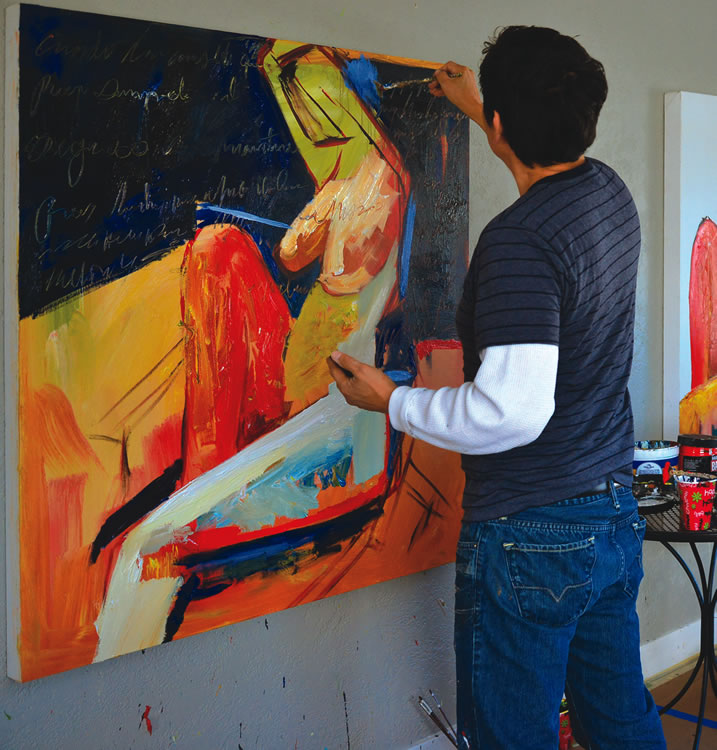
About six years ago, a commission to design a mural at a home in Beverly Hills, Calif., grew to include a painting of the owner’s wife that incorporated specific colors. The large piece of art spawned a series of commissions of similar works, allowing Hugo to develop a robust portfolio of acrylic portraits.
He took the initiative to produce a brochure of his work and distributed the pamphlet to several art galleries in the downtown Laguna area, which led to him landing a spot at Townley Gallery on Pacific Coast Highway in 2008. He exhibited at Townley until 2012, and today his eponymous gallery sits just feet from the space that first displayed his art.
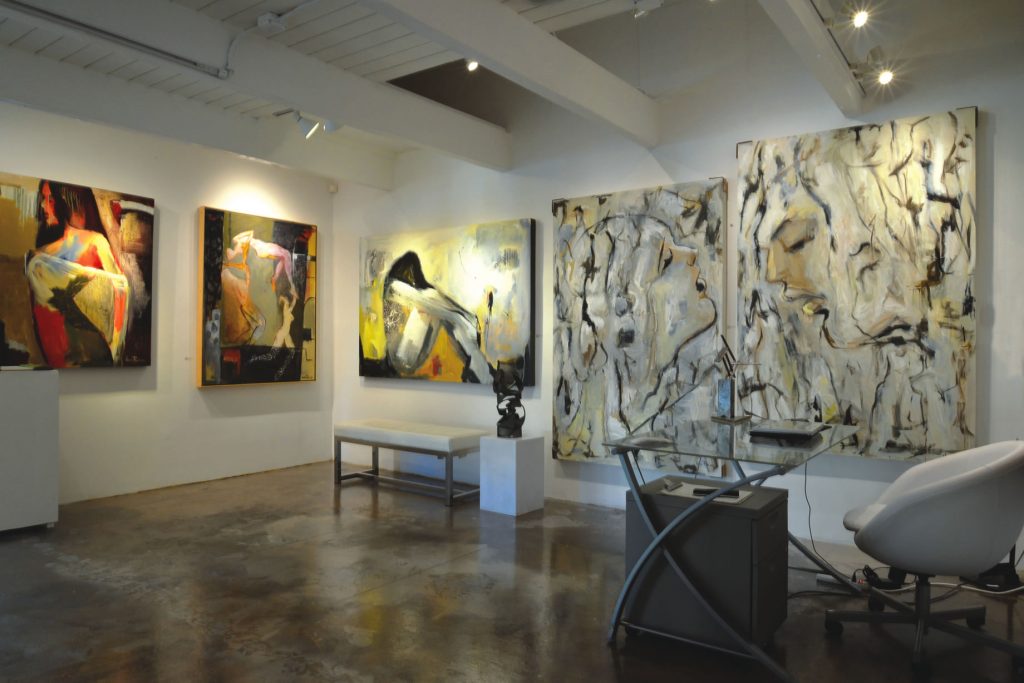
Although depictions of the female form are something of a signature of Hugo’s work, women are not his sole subjects. He prefers to paint abstracted portraits, he says, but often chooses to shine a light on musicians, horses, children and the faces of older people.
“The female form has so much rhythm,” Hugo explains. “The more rhythm you have, the more interesting [the work is]. The female form gives me rhythm, motion and feelings.” Still, he’s quick to emphasize that his work is more about emotions than the physicality of his subjects: “That’s what I’m trying to show. It doesn’t matter if it’s a man or a woman.”
Local Inspiration
Hugo and his wife, Erika, moved to Laguna Beach two years ago—the same time everything seemed to fall in place, according to Hugo. The couple married on the beach near Las Brisas restaurant in 2010, back when Hugo was still a fixture at Townley. His local friends pointed out that a rental was available in south Laguna, and then, in a moment of serendipity, a gallery space just 3 miles from the home became available downtown. The space, located at 550 S. Coast Hwy., now houses the Hugo Rivera Gallery.
“It’s amazing how things happen so quickly,” Hugo says. “I can’t believe it. It seems like we already knew we would be in this area.”
Prior to becoming a resident, Hugo would frequently visit Laguna’s galleries while taking classes in art history, design, composition and education at Orange Coast College between 1991 and 2011. He continues to list Laguna as one of his primary inspirations: “Laguna, unconsciously, does inspire me. In the mornings I walk to the beach and go from Coyote Grill to Montage resort. Then, looking at all the birds, pelicans, waves … sometimes the waves are so beautiful and the color of the sand and rocks—it inspires me, and I get energized.”
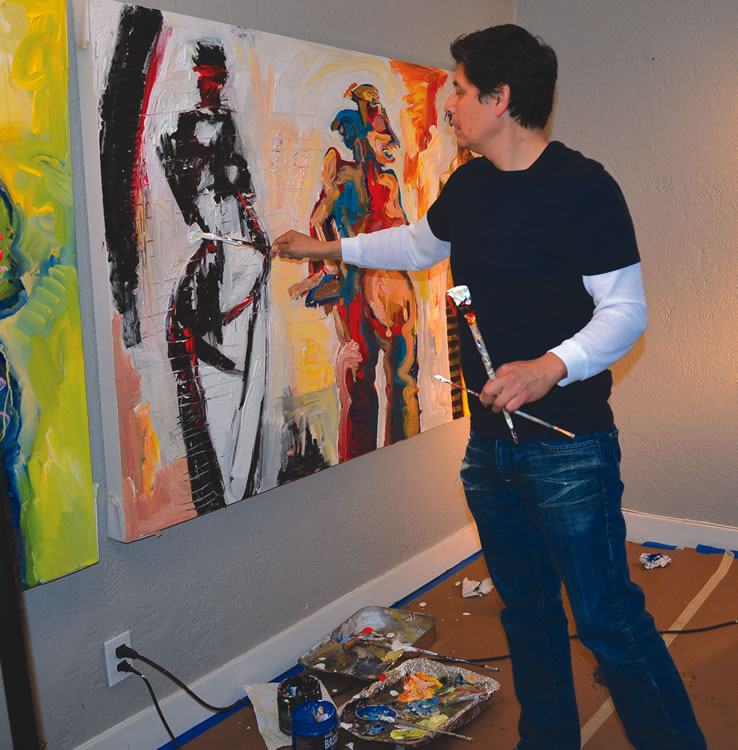
Music also plays a very important role in inspiring many of Hugo’s paintings. “Music transports you,” he says. “It guides me and leads me. I follow the rhythm of the music. It’s an accompaniment to painting.”
When he first arrives at the gallery each day around 9:30 a.m., one of the first things he does is log in to his Pandora account to stream music. Depending on his mood, the tunes he chooses can range from standard and Latin jazz to Carlos Santana, reggae, blues, flamenco and tango. He credits his appreciation of music to his father, remembering how Jose would listen to the works of Beethoven and other classical masters. “My father appreciated art so much,” he muses.
Hugo can be found at the gallery three to four times a week, setting up other artists’ paintings in an alley-style courtyard set back from the highway or working on his own pieces. If he takes a lunch break, he’ll often eat at the gallery or stop by GG’s Bistro for a veggie hamburger with a salad—then it’s back to painting.
If he’s not painting, he’s taking photos of the gallery and his work, or interacting with clients and anyone else who stumbles in. “It’s educational. It feels comfortable for the clients and artists [for me] to answer questions from clients,” Hugo says. At the end of the day, he busies himself by putting away paintings, cleaning brushes and making sure everything else is in order before heading home to upload images and have dinner with Erika, who is expecting their first child in April. In contrast to the unpredictability of his art, Hugo’s days are relatively routine, at times even regimented.
He remains committed to inspiring another generation of artists through single-day, hands-on workshops held throughout the year. During the six-hour seminars, Hugo shares his knowledge, demonstrating just how he composes his pieces, sharing helpful techniques and providing motivational guidance.
“The class is more about losing the fear of painting,” he says. “Some people take a workshop to see how I create, and they aren’t interested in being artists themselves. Some want to improve or enrich their technique. And some learn that you can break rules.”
In addition to maintaining the gallery and staging workshops, Hugo is planning a collaborative exhibition to be held this summer that will see several artists contribute to the same piece. He completed a similar project in 2013, producing 12 paintings in partnership with Mexican painters Vladimir Cora, whose work has been displayed at Hugo’s gallery, and Francisco Javier Vázquez Estupiñán, who paints and exhibits under the moniker Jazzamoart.

He’s also considering tackling another medium. “I want get back to sculptures,” he says. “Maybe that will be the next thing. My first early work was very abstract. I love it. I’m going back in that direction. … My real passion is the more abstract.” LBM



